Aquatic plants are important components of the ecosystem of a pond or lake. Aquatic vegetation provides food and cover for fish and beneficial invertebrates, such as insects and snails, and serves as the primary source of dissolved oxygen in pond water. However, overabundant plant growth can hamper fish production and interfere with fishing, swimming and boating (Figure 1).
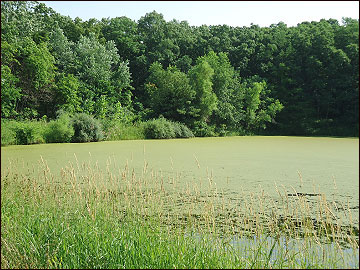 Figure 1
Figure 1
An overabundance of filamentous algae and duckweed covers this pond, interfering with fishing and other recreational activities.
For the purposes of this guide, aquatic plants are grouped into four categories: algae, submerged plants, emergent plants and floating plants.
Algae are primitive plants without stems, leaves or roots. Some species are microscopic, such as planktonic algae, and others are thin, stringy or hairlike, known as filamentous algae (Figure 2). Still others, such as species of Chara, are larger and resemble higher plants but lack true roots. One species, commonly referred to as blue-green algae, is actually colonized bacteria with plant pigments. Blue-green algae can cause problems in a pond and can even produce toxic chemicals that affect the flavor of affected fish. It is important to accurately identify the type of algae that may be causing problems in your pond. Refer to Texas A&M Extension for photos and additional information.
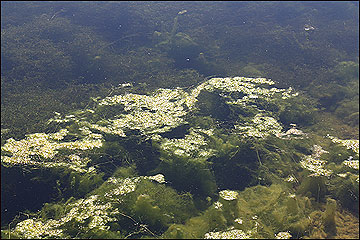 Figure 2
Figure 2
An overabundance of algae in ponds can cause problems and interfere with fishing and other recreational activities.
Submerged plants are rooted in soil with most of the plant below the water’s surface. Submerged plants typically have soft stems, so they do not usually rise above the water’s surface. Coontail, milfoil and pondweed are just a few examples of submerged plants (Figure 3).
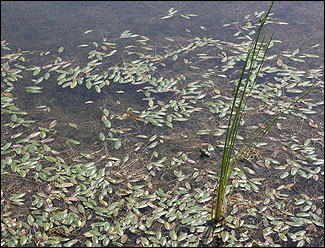
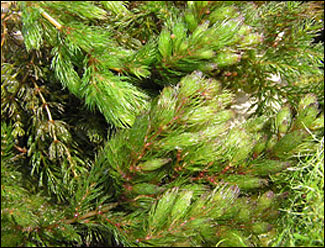
Figure 3
Emergent and submerged plants such as American pondweed, left, and coontail, right, are rooted at the pond bottom but develop large tangled masses of stems and leaves that float freely in the water. Pondweeds have submerged and floating stems and leaves that can quickly spread. Coontail has bushy stems that grow to 6 feet or more in length that can also float on top of the water.
Emergent plants are rooted in the pond bottom or adjacent to the pond, stand above the surface and, unlike submerged plants, generally have stiff or firm stems. Emergent plants — such as cattails, smartweeds, water primrose and reeds — are often referred to as “marginal plants” because they tend to grow along shorelines and in shallower areas near the pond bank, depending on water level fluctuations (Figure 4).
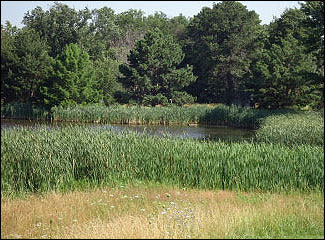
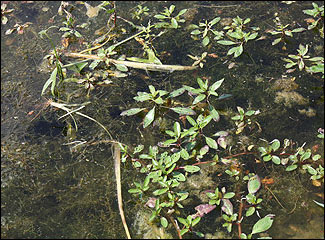
Figure 4
Cattails, left, can quickly spread and completely take over the edges of a pond. Water primrose, right, often grows near the shoreline and forms dense mats in shallow areas of the pond.
Floating plants are seed-bearing plants that float freely on the water’s surface or have leaves that float on the surface of the water (Figure 5). Floating plants vary from the small, such as duckweed, to those over a foot in diameter, such as water lilies, American lotus and water hyacinth. Most have leaves connected by long stems to roots in the lake bottom.
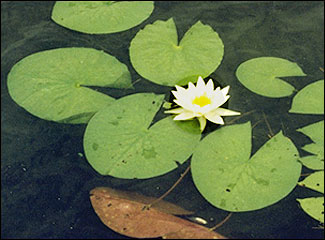
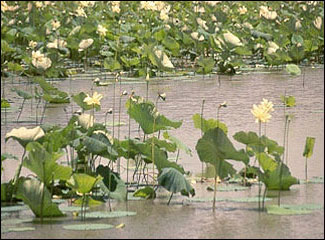
Figure 5
Water lilies, left, and American lotus, right, are among the most beautiful of aquatic plants. However, both species can spread rapidly in shallow water and become a problem, particularly if fishing is a priority.
Aquatic vegetation can be controlled using cultural, biological and chemical methods. Methods aimed at preventing vegetation problems are often the most successful, but control usually requires a combination of methods, as no single strategy provides satisfactory long-term results. This guide provides a general overview of each control method and discusses implementation strategies to help you make informed decisions about aquatic plant control.
Cultural control
Cultural methods of controlling aquatic plants include prevention, habitat alteration and mechanical control. The success of each method depends on the circumstances and severity of the aquatic vegetation problem.
Prevention
Preventing an aquatic weed problem is easier than solving one. Prevention begins with proper planning, construction and management of a pond or lake.
Preventive measures include proper pond site selection within a watershed and considerations during the design and construction phases. Pond depth is important to vegetation management and survival of healthy fish populations. For example, emergent plants rooted in soil cannot grow without sunlight reaching the pond bottom. Deepening shallow pond edges to at least 3 feet reduces aquatic plant growth in those areas. Most ponds in Missouri with 1 or more surface acres should have at least 10 feet of water at the deepest location. In Missouri, 1 acre of water is usually adequate for every 10 to 20 acres of watershed. Aquatic vegetation problems are often caused by an increase in nutrients draining into a pond from the watershed. Avoid locations with nutrient-rich runoff, such as from a livestock feeding area, domestic lagoon or septic tank field.
Refer to MU Extension publication G9474, Guide Pond Construction and Management Considerations, for information on proper siting, design and construction of a pond.
Altering habitat
Several control methods involve altering aspects of the pond habitat to remove or kill off nuisance plants.
Manipulating the pond water level can prevent and control nuisance aquatic vegetation. Lowering a pond’s water level, referred to as a drawdown, during fall and winter months exposes vegetation to dry conditions and harsh weather. The degree of control over water level varies with the severity of the winter, but drying out soil and exposing aquatic plants to such harsh conditions can help with aquatic plant management.
Several methods involve depriving aquatic plants of sunlight to stop their spread or kill them off. Using a dye in a pond prevents sunlight from reaching submerged aquatic vegetation. Dyes can be applied at a rate of 1 quart per acre-foot of water. However, this shading technique is ineffective in flowing water because flowing water dilutes the dye. As an alternative to using dyes, covering small areas of the pond with 8-millimeter-thick black plastic sheeting kills most aquatic plants under the sheet in about 30 days. Float the plastic on the surface and anchor it, or sink the sheet over the problem plants with weights.
Applying fertilizer when pond water is clear can prevent aquatic plant problems by stimulating growth of planktonic algae that absorb sunlight before it reaches submerged plants on the pond bottom (Figure 6). Applying fertilizer can further benefit the pond food chain by stimulating growth of phytoplankton and zooplankton, which are important sources of food for fish. A typical application rate is 50 pounds of a 16-20-4 N-P-K — nitrogen, phosphorus and potassium — fertilizer per surface acre. Fertilizer applications often must be continued through the summer at monthly intervals to achieve results. If a white object or secchi disc can be observed at depths greater than 18 inches, then fertilizer applications may be beneficial. Do not fertilize ponds that are muddy or have abundant aquatic plant growth, an existing dense phytoplankton bloom, out-of-balance fish populations, or excessive water flow.
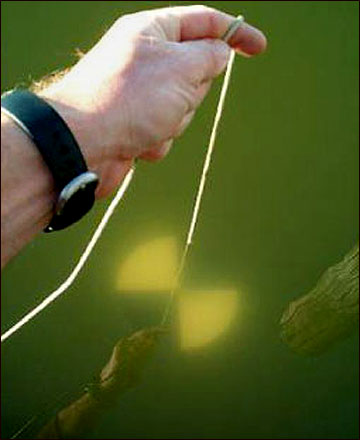 Figure 6
Figure 6
A white object or a Secchi disc — as shown here — can be used to measure water clarity. An ideal phytoplankton bloom makes the water green and limits visibility to about 18 inches below the pond's surface.
Mechanical control methods
Controlling aquatic plants with mechanical means can be effective and often yields longer-lasting control compared to chemical methods. Mechanical methods remove aquatic vegetation by hand-pulling, raking and using chains or other heavy items. If a pond slope has settled over time, edges can be deepened to 3 feet with a backhoe or track hoe after conducting a drawdown during the fall or winter.
Small stands of cattails can also be removed by hand. Cattails have tuberous roots that must be removed along with the green stem and leaves that are above the water. If cattails have accumulated silt and runoff soil, remove them with a backhoe. Mats of algae and floating duckweed can also be raked and mechanically removed from the pond.
Biological control
Biological control methods include the use of plant-eating fish, such as grass carp (Figure 7). This species is used to control aquatic vegetation in Missouri ponds and is often recommended during the initial stocking of a pond. Grass carp can eat up to three times their weight each day and can gain up to 10 pounds in a year. If more than 10 to 15 percent of the surface area of a pond or lake is choked with vegetation, you can stock 8- to 10-inch grass carp fingerlings at a rate of five to 10 per surface acre. You can find additional information on using grass carp for aquatic plant management and for proper stocking rates at the Missouri Department of Conservation.
Other methods of biological control include managing phytoplankton blooms. Phytoplankton are an important part of the aquatic food chain, but a dense bloom can reduce the amount of sunlight that reaches the pond bottom and affect the water’s turbidity. Turbidity refers to the amount of sediment suspended in water, which affects how much light penetrates the water. Adequate phytoplankton populations prevent sunlight from reaching the pond bottom and thus discourage establishment of nuisance plants.
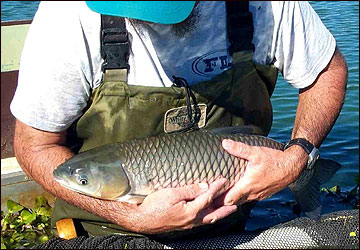 Figure 7
Figure 7
Grass carp are a nonnative, plant-eating fish that will reduce the abundance of some aquatic plants in the pond.
Chemical control
Using chemicals to control aquatic vegetation can be expensive and difficult and will not be successful unless the aquatic plants to be controlled are properly identified. Various aquatic herbicides are labeled for controlling different plants, but herbicides are ineffective unless matched with the plant they are designed to target and applied at the correct time and at the proper rate.
In certain circumstances, herbicide use can also negatively impact water quality in ponds. Research conducted by the University of Missouri Limnology Laboratory has documented these impacts as well as negative impacts that result from algaecide use for controlling blue-green algae. Refer to Algaecides and Copper Sulphates (PDF) for more information.
Plant identification
Properly identifying the problem plant is the first step. Texas A&M University hosts an excellent online resource for identifying aquatic plants, learning about control recommendations and reviewing product labels at Texas A&M Extension. The Missouri Department of Conservation also has resources that can help you identify aquatic plants.
Choose the appropriate herbicide
Aquatic herbicides are tailored to control certain plant species, so once you have identified the plant species to be controlled, determine the appropriate herbicide, the recommended timing and rate of application, the proper plant growth stage for application, and the area of the pond to be treated.
Safety concerns; choosing whole-pond or spot treatment; ease of application; water-use restrictions; and cost all factor into deciding which herbicide to use. Manufacturers’ websites list herbicide labels so you can compare products, evaluate costs and make the correct selection. Table 1 lists select herbicides labeled for controlling common aquatic plants in Missouri.
Herbicides are most effective when applied to young, actively growing vegetation. Most aquatic plants begin growing in early spring when temperatures are around 60 degrees F. April and May, when water temperatures warm up to 70 degrees F, are ideal times for applying herbicides.
Most importantly, follow all label directions and water-use restrictions when applying aquatic herbicides. The label is the law. Aquatic herbicides are not toxic to fish when applied in accordance with label directions and water-use restrictions, but failure to follow label directions can result in a fish kill. The applicable water-use restrictions for aquatic herbicides will be identified on the herbicide label. For example, there may be waiting periods after an application before pond water can be used for livestock watering, swimming, irrigation or other uses. If the label calls for a surfactant — a chemical additive that helps herbicides stick to and penetrate into the plant — use a product registered for use in a pond or lake. Surfactants should often be applied with herbicides used to control floating or emergent plants.
Table 1
Response of some aquatic plants to treatment with registered herbicides or grass carp.1
| Aquatic group and vegetation | Carfentrazone | Copper complexes Copper sulfate | Diquat | Endothall | Flumiox- azin | Fluridone | Glyphosate | Imazamox | Imazapyr | Penoxsulam | Sodium carbonate peroxyhydrate | Triclopyrh | Grass carp | |
|---|---|---|---|---|---|---|---|---|---|---|---|---|---|---|
| Algae | ||||||||||||||
| Chara, Nitella | G | G | P–G1 | P | E | |||||||||
| filamentous | G | G | P–G1 | G | G | |||||||||
| planktonic | G | G | G | F | G | |||||||||
| Floating plants | ||||||||||||||
| duckweed | G | F | P | G | P | E | E | G | E | P | ||||
| salvinia | G | P | E | F | G | E | G | E | G | E | ||||
| watermeal | F | P | F | E | G | G | ||||||||
| water hyacinth | F | G | F | G | P | F | G | G | G | E | G | |||
| water lettuce | G | F | F | E | E | G | F | G | E | E | G | |||
| Emergent plants | ||||||||||||||
| American lotus | G | P | E | E | G | E | ||||||||
| alligatorweed | F | P | G | P | G | G | E | G | ||||||
| arrowhead | E | G | G | E | G | E | E | |||||||
| bulrush | G | F | P | G | ||||||||||
| cattails | F | G | P | F | E | E | E | F | ||||||
| phragmites | P | G | G | E | P | |||||||||
| smartweed | G | F | P | F | E | G | G | G | E | |||||
| waterlilies | G | G | G | E | E | E | F | G | ||||||
| watershield | E | F | F | F | G | E | G | E | E | |||||
| water pennywort | G | F | G | F | G | E | E | E | G | |||||
| water primrose | P | G | G | G | P | E | E | E | G | |||||
| willows | E | F | P | P | F | E | E | |||||||
| Submerged plants | ||||||||||||||
| bladderwort | G | G | P | E | F | G | ||||||||
| coontail | G | E | E | G | G | G | G | |||||||
| elodea | G | F | F | G | E | E | G | E | ||||||
| hydrilla | G | F | F | E | G | E | G | E | E | |||||
| milfoils | G | E | G | E | G | E | G | G | G | P | ||||
| naiads | E | G | E | G | F | E | ||||||||
| parrotfeather | F | G | G | E | G | E | F | G | G | F | P | |||
| pondweeds | F | E | G | E | G | G | E | |||||||
| spikerush | P | E | G | |||||||||||
E = Excellent
G = Good
F = Fair
P = Poor
Blank = Unknown or no response.
1 Good control achieved with hydrothol formulations, poor control with aquathol formulations.
Application rates
Calculating the proper rate of application is crucial to effectively controlling nuisance aquatic plants. Found on herbicide labels, application rates are expressed in acres of surface water to be treated or acre-feet of water to be treated.
Surface acre treatments are determined using this formula:
Water surface area, in acres × rate of product application per surface acre = Amount of herbicide to be used
Volume treatments are used for herbicides that list their application rates in terms of amount used per acre-foot of water. An acre-foot of water is the amount of water in 1 surface acre to a depth of 1 foot, or about 326,000 gallons of water. In ponds, water volume is determined by multiplying the surface area of the pond, in acres, by the average depth, in feet. You can calculate the pond’s surface area by multiplying its length by its width. The formula below provides useful calculations and conversion factors needed for correctly applying aquatic herbicides in ponds on an acre-foot basis.
Surface area of water × average depth of water, in feet × rate of product application = Amount of herbicide
Calculations may also be needed for applying herbicide treatments in parts per million by weight (ppmw), which is the final concentration of the chemical in water. The amount of herbicide needed for a ppmw treatment is determined by the following formula:
F = (A × D × C × E) ÷ I
F = amount of formulated herbicide
A = surface area of water, in acres
D = average depth of water, in feet
C = 2.72 pounds per acre-foot is a conversion factor when total water volume is expressed in acre-feet; 2.72 pounds of herbicide per acre-foot of water is equal to 1 ppmw
E = effective chemical concentration of the active ingredient of herbicide needed to control a particular aquatic weed
I = amount of active ingredient divided by the total amount of active and inert ingredients:
- For liquid products, it is the pounds of active ingredient per gallon
- For dry products, it is the percent of active ingredient divided by 100
These are example formulas for calculating various treatment rates. Refer to an aquatic herbicide’s product label for specific information on accurately calculating rates, following precautions and safely using these products.
Table 2
Common trade names for aquatic herbicides
| Active ingredient | Trade names |
|---|---|
| 2,4-D | Aquacide, AquaKleen, Navigate and many others |
| Carfentrazone | Stingray |
| Copper sulfate and copper complexes | Agritec, Copper Sulfate, Cutrine, Cutrine Plus, K-Tea and many others |
| Diquat | Diquat SPC 2L, Harvester, Reward, Tribune, Tsunami DQ, Weedtrine D |
| Endotholl | Aquathol K, Aquathol Super K, Hydrothol 191 |
| Flumioxazin | Clipper |
| Fluridone | Avast, Fluridone, Restore, Sonar, WhiteCap |
| Glyphosate | AquaNeat, Aquamaster, Eraser AQ, Refuge, Rodeo and many others |
| Imazamox | Clearcast |
| Imazapyr | Arsenal, Habitat, Polaris |
| Penoxsulam | Galleon |
| Sodium carbonate peroxyhydrate | Green Glean, PAK 27, Phycomycin |
| Triclopyr | Ecotriclopyr, Navitrol, Renovate |
Conducting small spot treatments
Aquatic plants killed with an herbicide quickly begin to decompose, which uses available dissolved oxygen in the water. When aquatic plant growth increases in summer months, decomposition that occurs after a whole pond is treated with an herbicide could use so much oxygen that fish would suffocate in the oxygen-depleted water. Plant decomposition occurs faster and dissolved oxygen is used much quicker in higher water temperatures.
Treating small portions of a pond at a time can effectively control nuisance aquatic plants while minimizing the risk of a fish kill. Spot treatments create zones devoid of aquatic plants while maintaining larger areas of quality habitat for aquatic life. Treat no more than 20 to 25 percent of the pond area with an aquatic plant problem at once. After three weeks, treat another 20 to 25 percent of the area. Continue to alternate these applications at this interval until the complete area affected by nuisance plants is treated.
Precautions and legal concerns for herbicide use
Aquatic herbicides must be registered and labeled for use by the U.S. Environmental Protection Agency (EPA).Once an aquatic herbicide receives a national registration, it must also receive approval by the state agency charged with pesticide registration. Contact the Missouri Department of Agriculture’s Plant Industry Division for information on herbicides registered for use in Missouri that can be used for aquatic plant management. They also have information on updated herbicide labels, which are subject to change at any given time. Visit their website at agriculture.mo.gov/plants/pesticides/ to learn more.
As of 2011, all aquatic applications of herbicides fall under the EPA’s National Pollution Discharge Elimination System (NPDES). You may need a permit to apply an aquatic herbicide if the chemical leaves a residue and the pond discharges water directly into a stream or other waters. Most ponds in Missouri do not directly discharge waters into streams. When in doubt, contact the Missouri Department of Natural Resources for information.
The recommendations and information in this publication are generic in nature; unforeseen circumstances may reduce the effectiveness of an aquatic herbicide. Applying an aquatic herbicide makes you responsible for the effects of herbicide residues on livestock or crops as well as any problems that arise from movement of herbicides from a treated pond to other locations.
Table 3
Water use restrictions for common aquatic herbicides.
| Active ingredient | Human use | Livestock | Irrigation | |||
|---|---|---|---|---|---|---|
| Drinking | Swimming | Fishing | Watering | Turfgrass | Crops | |
| Number of days between treatment and use | ||||||
| 2,4-D | a | a | a | a | a | a |
| Carfentrazone | 0–1b | 0 | 0 | 0–1b | 0–14b | 0-14b |
| Copper sulfate and copper complexes | 3c | 0 | 0 | 0 | 0 | 0 |
| Diquat | 1–3d | 0 | 0 | 1 | 1–3d | 5 |
| Endotholl | 7–25d | 1 | 0 | 7–25d | 7–25d | 7–25d |
| Flumioxazin | 0 | 0 | 0 | 0 | 0–3d | 5 |
| Fluridone | 0 | 0 | 0 | 0 | 7–30d | 7–30d |
| Glyphosate | 0 | 0 | 0 | 0 | 0 | 0 |
| Imazamox | 0 | 0 | 0 | 0 | 1 | 15 |
| Imazapyr | 0 | 0 | 0 | 0 | 120f | 120f |
| Penoxsulam | 0 | 0 | 0 | 0 | 0 | g |
| Sodium carbonate peroxyhydrate | 0 | 0 | 0 | 0 | 0 | 0 |
| Triclopyr | 0 | 0 | 0 | 0 | 0 | 0h |
aRestrictions vary dramatically based on formulation, rate, etc. Read specific 2,4-D product label carefully for instructions.
bRestriction varies if 20 percent or more of surface area is treated.
cThe elemental copper concentration for drinking water should not exceed 1 part per million.
dDepends on formulation and/or rate applied. Read specific product label carefully for instructions.
eDo not use treated water to irrigate greenhouses or nurseries, or for use in hydroponics.
fDo not use treated water for 120 days or until imazapyr residue levels are determined to be 1 part per billion or less.
gDo not use treated water for food crop irrigation until residue levels are determined to be 1 part per billion or less.
hDo not use treated water for irrigation until triclopyr residue levels are determined to be 1 part per billion or less.
Conclusion
Aquatic plants are an essential part of any successful pond or lake. They are the foundation for the aquatic food chain and provide food for waterfowl and aquatic mammals that feed on tubers, seeds and leaves. Many aquatic plants provide nesting sites and protective cover for life in the pond and help minimize erosion by stabilizing pond banks. There are several methods and products for controlling aquatic plants, but the best solution usually integrates more than one control method.
Additional information
USDA Southern Regional Aquaculture Center publications:
- Aquatic Weed Management: Control Methods, SRAC publication 360.
- Aquatic Weed Management: Herbicides, SRAC publication 361.
- Calculating Area and Volume of Ponds and Tanks, SRAC publication 103.
Missouri Department of Conservation publications:
- Missouri Pond Handbook.
- Pond improvements, pond construction, maintenance, aquatic plant management and complete aquaguide series of guides. 2013. Missouri Department of Conservation.
- Texas A&M University’s aquaplant website.
- Missouri Department of Agriculture.
- Missouri Department of Natural Resources.
University of Missouri Limnology Laboratory and Aquatic Ecology Lab.
Photo credits
Robert Pierce, Charles Hicks and Missouri Department of Conservation
The University of Missouri intends neither endorsement of products named in this guide nor criticism of similar products that are not mentioned.